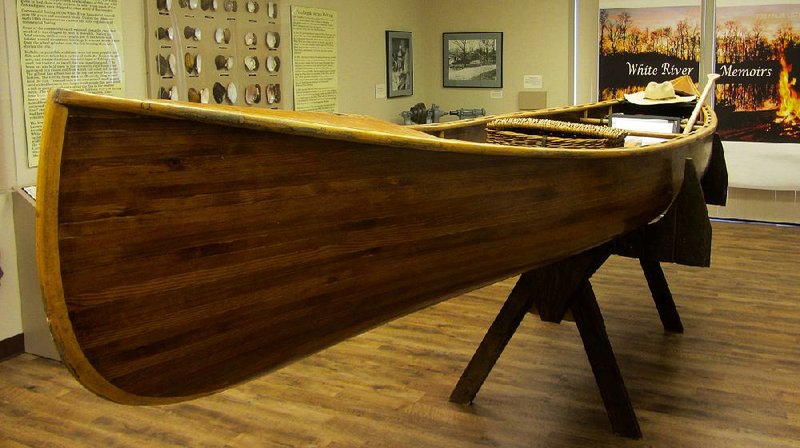DES ARC -- The canoe on special exhibit at Lower White River Museum State Park is more than just a means of conveyance, although it has traveled the length of the storied Arkansas waterway.
The boat is a gorgeous work of art, handmade by Chris Engholm from cedar, maple and cherry woods. Sleek enough to qualify as a Cadillac of canoes, it even has a name, fondly bestowed by its creator. He calls it Ballad Hunter.
The canoe is the centerpiece of writer and photographer Engholm's "White River Memoirs" exhibition, at the museum for most of this year. An information panel provides his explanation of the vessel's name:
"The ballad hunters of old were musicologists like John and Alan Lomax who roamed the hills of the Appalachians and Ozarks in search of Old World melodies and lyrics still in use in the New World. A ballad hunter is a seeker of song and dramatic tales."
As the museum's contents testify, there are plenty of dramatic tales to be spun about life along the lower White River since the first permanent European settlers showed up more than 200 years ago. The narratives tell of successes but also setbacks, leaving a sense that the best times around here came before the White River was tamed by dams after World War II.
In a posted comment written in 1892, German immigrant Hugo Preller told his wife, "There's no money in this country, but we could live off the fat of the land."
An information panel reports that "game was still plentiful here and the fishing spectacular. By 1915, a vibrant riverboat culture of trappers, shellers, fishers and loggers prospered along the lower river's bountiful shores. Vast quantities of fish and roe were shipped to St. Louis, Chicago and New York. The Delta became a main supplier of shell buttons as well as pearls.
"Sadly, this era began to fade after 1970 due to the ecological changes brought on by the dams upstream."
Another panel of lamentation describes the White River "endlessly meandering through a once impenetrable hardwood forest of hickory, oak and pine in the uplands, and tupelo and bald cypress swamp-forest in the bottoms."
This terrain is "the remnant of the 'Big Woods of Arkansas,' the scene of one of America's most regrettable ecological disasters. Over 7 million acres of bottom-land hardwood forest were razed here in the 1940s-'60s -- over 90 percent of this critical waterfowl refuge lost."
On a lighter note, the museum displays a photograph taken at a 1909 baseball game to raise funds for the Des Arc library. Lined up next to each other, the two amateur teams show a striking difference. The local newspaper reported the event under the headline "Fats vs. Leans":
"As has been arranged for, the fat and lean men of the city, having become enthused over baseball, chose sides and selected their men -- the fattest and leanest in town."
For the winning Leans, "the features were B.B. Bethell and his famous bird dog, which in trying to keep up with his master on the run, headed him once or twice and sent the old gentleman head over heels to the next base. Hays Kerin is said to be built for running, and was given up to be, by the ladies present, the trimmest and cutest on the field."
Lower White River Museum State Park, 2009 Main St., Des Arc, is open 8 a.m.-5 p.m. Tuesday-Saturday, 1-5 p.m. Sunday. Admission is free. For more information, call (870) 256-3711 or visit ArkansasStateParks.com.
Weekend on 05/19/2016
